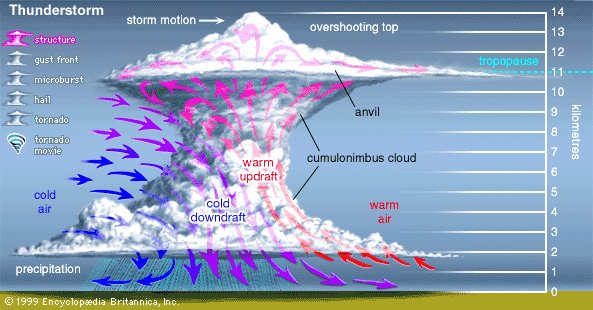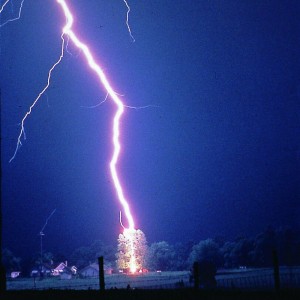The anatomy of thunderstorms
Thunderstorms are funny things. They can be beautiful, with spectacular displays of lightning streaming like fireworks across mottled purple and green skies. They can be loud and imposing, windy, or relatively calm. They can be pleasant spectacles, watched from the safety of a home on a hot summer day, or terrifying forces of danger for a stranded hiker.
As May approaches, so does the first thunderstorm of the season. Warm air and light breezes combined with moving storm fronts makes for a brew of spectacularly unpredictable weather during the late spring.
Before a storm occurs, a lot has to happen to create just the right circumstances for a thunderstorm. First, there has to be a lot of moist air hovering near the ground. This is often the case in valleys and areas near mountains, where air continuously cycles throughout the day, pushed upward in part by the geographical barrier of the hills.
Next, that moist air must be heated by radiation from the sun. Thunder storms typically occur in the summer months, not just because the air is warmer, but because the ground is exposed and thus absorbs radiation from the sun as hear instead of reflecting it upward the way a snowy surface does.
Once warmed, the moist air will continue to rise, encountering increasingly cooler air as it does. This process is called convection. As the moist, warm air rises, it cools and water molecules condense on particulates in the atmosphere, creating a cloud of water vapor (NOAA).
As the cloud continues to rise, more and more of the vapor it contains condenses until it reaches upward in a mushroom-like column. Once the very top of the cloud reaches air whose temperature is below freezing, the condensation droplets begin to freeze into ice crystals, grabbing other particles along the way.
Just as warm air rises, cool air falls, and this perpetual cycle of moving air causes water particles to collide. When they do they may rub against each other or rip off part of each others’ crystal structure, generating small sparks and charges. If the cloud is big enough for charge to grow across the whole structure, it will shoot out feelers, bolts of lightning “seeking” a conductive surface to complete the circuit within the cloud.
All the while, the condensed water may precipitate, falling as rain or being kicked out of the convection cell as hail. Winds pick up as the convection cycle churns the air around the storm, and the temperature near the surface of the Earth drops.
Lightning, one of the most perilous features of thunderstorms, is unpredictable. We know how it is generated, and that it occurs when opposite charges build up within a cumulonimbus cloud or between a cumulonimbus cloud and an object on the ground. Once a substantial potential has developed, electricity is discharged as lightning. Energy from a lightning channel or leader can heat the air around it to 18,000 degrees F (NOAA).
Only about 10 percent of lightning strikes are fatal. About 70 percent of people struck by lightning report that they experience permanent effects such as personality change, brain damage, or burns. The odds of getting struck by lightning in a given year in the United States are 1 in 700,000 (National Geographic News). If you find yourself within earshot of thunder, you can reduce the likelihood of your being struck by seeking shelter. If you are in the woods, it is best to get below tree line and to avoid tall, free standing objects.
This tremendous force causes the air molecules near the leader to separate, creating sound waves that travel through the air as thunder. Thunder can be heard from up to 25 miles away from the lightning that causes it.
When heard at close proximity, it resonates as a series of disturbing clicks, like the gentle tapping of a circuit connecting in a high school physics classroom. People who have been struck by lightning describe hearing such clicks in conjunction with the hairs on the back of their necks rising in response to the build up of static charge in the air around them.
If you are particularly interested in extreme weather, you can participate in The National Weather Service’s SKYWARN project. SKYWARN is a data collective comprised of collaborative work by community volunteers. It has been running since the 1970’s to help NWS better predict storms that will likely cause a lot of damage.
For more resources regarding lightning safety in the backcountry, check out the National Outdoor Leadership School’s (NOLS) website.









